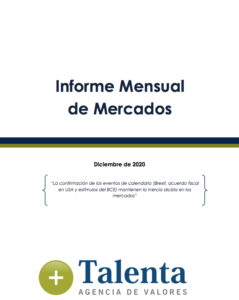Key Aspects:
The month of December began with the ECB meeting at which Lagarde announced the € 500 billion increase in the Pandemic Emergency Procurement Program. In addition, it extended the program for another 9 months until March 2022. In the United States, the Fed maintained its monetary policy unchanged, although it leaves the door open to increase the volume of purchases in case necessary. On Friday 11 December, the 10-year Spanish bond reached a negative IRR for the first time in its history when, just 8 years ago, in 2012, the figure stood at 7.50%. Poland and Hungary have finally reached an agreement with the European Union. The budget is allowed to approve the European Reconstruction Program. For its part, the U.S. Senate has reached an agreement for a $ 900 billion stimulus plan to alleviate the impact of the pandemic. The financial injection is aimed directly in part at the pockets of citizens, with payments of $ 600 per person based on their income. This is the main bullish factor in the month. As for the COVID-19 vaccine, both the United States and Europe are already in the vaccination phase. For the U.S. vaccination campaign, Donald Trump had planned to vaccinate 20 million Americans before the end of the year, but according to the Centers for Disease Control and Prevention, they have only been vaccinated 2 million people in the United States. The European Commission authorized the Pfizer vaccine on December 21 hours after the European Medicines Agency confirmed its effectiveness. The pace of vaccination is not as expected.
Finally, after several months of intense negotiations and four years of political earthquake caused by Brexit, on December 24, both sides sealed the agreement that will define the future relationship of the United Kingdom with the European Union.


